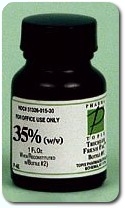Trichloroacetic acid (TCA)
Trichloroacetic acid (TCA):
 there are various concentrations of TCA available: from 10% to 50%: appropriate concentration of the applied peeling is chosen by the doctor in charge of the treatment, usually, these are concentrations ranging from 20-35%,
there are various concentrations of TCA available: from 10% to 50%: appropriate concentration of the applied peeling is chosen by the doctor in charge of the treatment, usually, these are concentrations ranging from 20-35%,- the TCA solution is applied to your skin with a Q-tip or brush over the target skin area,
- during the peel, after 1-3 minutes, your skin will tingle, feel prickly, and turn hot; the discomfort may be eased by using a cooling fan or cold packs,
- at this time, the patient's skin turns white (frosting), which is a proper skin reaction to TCA,
- unpleasant sensation lasts from dozen or so seconds up to a few minutes; it depends on individual skin sensitivity,
- for a deeper peel, two or even three layers of peel solution may be applied, especially, in the areas where we expect the biggest effect, for a better result, it is also possible to apply slight pressure in order to enhance the TCA penetration;
Indications for TCA:
- brown spots, age spots, freckles,
- photodamaged skin,
- fine lines,
- atrophic acne scars;
Skin care after TCA peeling:
- immediately after the session, the treated skin is pink/red and parts of it turn white (frosting), after a few minutes the frosting effect disappears, while the skin stays smooth,
- for most people, visible peeling starts after about 2-3 days, the treated skin turns brown, feels very tight and becomes to look crepey, then it starts to peel - the process lasts for about 3-4 following days,
- NEVER pick or pull off any exfoliating/flaking skin (!), as it may cause discolouration and/or scarring,
- during the phase of skin flaking, patients are advised to stay at home (for 3-4 days) - thus it is best to undergo the peeling on Wednesday or on Thursday and then the most intensive exfoliation phase falls during weekend;
Follow-up TCA sessions (4-6) are performed in office with about four week intervals.

